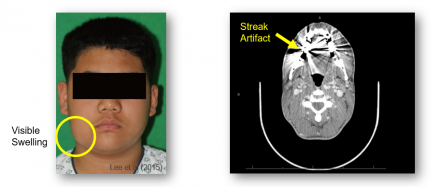A 35 yr old woman presents to the hospital emergency department with pain in the lower jaw.
Introduction
Meet Jane
- 35 year old woman with left-sided jaw pain
- Past medical history:
- Dental caries and filling in tooth #18
- Medications
- Over-the-counter analgesics (Acetaminophen)

Pain Assessment (Part 1)
Watch as the physician and Jane interact in the hospital emergency department.
Summary of Findings
Jane's chief complaint was left-sided jaw pain. An oral exam revealed no overt signs of infection, such as fever, swelling or fluctuance; and Jane experiences more intense pain when biting down on a tongue depressor.
- Left-sided jaw pain
- No overt signs of infection (i.e., fever, swelling, fluctuance)
- Tooth hurts when biting down on tongue depressor
Next Steps
Which of these steps should be next steps?
Computed Tomography
Computed tomography may be indicated when there is a history of trauma or significant soft tissue swelling.

CT with contrast would only be ordered if Jane displayed visible swelling, especially swelling that extends to the mandible as show in the image above. In Jane's case however, the doctor did not observe any swelling.
In computed tomography scans involving the oral region, a challenge in interpretation can be the scatter caused by the materials used in dental treatment. Dentistry uses many materials including various metal alloys, composites, porcelains, and ceramics. As seen in the image on the right, significant streak artifacts result from metal alloys found in dental restorations, orthodontic brackets, surgical plates, as well as dental prostheses not removed at time of scan. While software exists to diminish artifact, interpretation of the area with such artifact may be more difficult.
Incision and Drainage
Incision and drainage is indicated when there are visible signs of infection.

Incision and drainage is indicated when there are visible signs of infection, such as localized swelling and tenderness of purulence. The doctor did not observe any of these signs when she examined jane. Thus, incision and drainage is not an appropriate treatment.
The image on the left depicts a true dental abscess or infection. In this case, incision and drainage as shown in the image on the right would be indicated.
Local Anesthetic Block
Local anesthetic block is appropriate for short-term pain relief until definitive treatment can be obtained.
While many local anesthetic formulations exist, a good choice is 0.5% bupivacaine 1:200,00 epinephrine, which gives pain relief for 6-8 hours. Although 2 cc's are generally adequate, up to 8 cc's can be administered safely to most patients.
Antibiotics
Antibiotics are indicated only when there are overt signs of infection, abnormal vital signs, and/or an elevated temperature.

As with incision and drainage, antibiotics are indicated only when there are overt signs of infection. When Jane's vital signs were measured at the hospital emergency department, all parameters were in normal range. This finding, in combination with the lack of localized swelling and tenderness, strongly suggest that Jane does not have a dental infection and thus antibiotics are not indicated.
Pain Medication
In cases like Jane’s, pain medication can provide temporary pain relief until the patient can be seen by a dentist.
Because Jane's chief complaint is pain, prescribing an analgesic medication would be an appropriate treatment.
Two Categories of Analgesic
There are essentially two categories of medications for treating acute pain: non-opioid analgesics and opioid analgesics.
- Non-opioids
- Opioids
Non-Opioid Analgesics: Acetaminophen
Acetaminophen is one non-opioid analgesic. It typically is well-tolerated, with the most common side effects being nausea or dyspepsia. However, acetaminophen also can cause acute liver failure, and thus is contraindicated for patients with chronic severe liver disease or chronic alcohol use. It is dosed 325 to 500 mg by mouth every 4 t 6 hours, either scheduled or as needed, with a maximum daily dose of 4000 mg (or 4 g) a day. However, because of the risk of liver toxicity, it typically is recommended that patients take no more than 3000 mg per day.
- Well tolerated
- Adverse effects
- Nausea
- Dyspepsia
- Liver toxicity
- Contraindications
- Severe liver disease
- Chronic alcohol use
- Dosage
- 325-500 mg
- Every 4-6 hours
Non-Opioid Analgesics: Nonsteroidal Anti-inflammatory Drugs (NSAIDs)
Nonsteroidal anti-inflammatory drugs (or NSAIDs), such as ibuprofen and naproxen sodium, are another useful class of medications for treating acute pain, especially when the source of the pain has an inflammatory component. The main adverse drug reactions associated with short-term use of NSAIDs are nausea and vomiting, renal dysfunction (more specifically acute renal injury), and gastrointestinal bleeding. Thus, NSAIDS are contraindicated for patients with kidney disease, diseases of the gastrointestinal tract, and uncontrolled hypertension. The initial dosing of ibuprofen is 200 to 400 mg by mouth every 4 to 6 hours. This can be both scheduled or as needed. The maximum daily dose of ibuprofen is 2400 mg a day.
- Good for pain + inflammation
- Adverse effects
- Nausea and vomiting
- Renal dysfunction
- GI bleeding
- Contraindications
- Kidney disease
- GI disease
- Uncontrolled hypertension
- Dosage
- 200-400 mg
- Every 4-6 hours
Opioid Analgesics
Opioid analgesics, such as oxycodone, hydrocodone, or the combination of hydrocodone with acetaminophen, also are effective treatments for acute pain when patients have not responded to non-steroidal analgesics or have contraindications to other pain relievers. The most common adverse effect associated with opioid use is constipation, which can occur after even a single dose. Other adverse effects include nausea and vomiting, sedation, and respiratory depression. Opioids also have strong potential for dependency and thus are contraindicated in patients with a history of drug or alcohol abuse. They also are not indicated for persons with seizure disorders or who are currently taking drugs with serotonergic activity. The initial dosing of oxycodone is 10 mg every 12 hours as needed.
- Good if other analgesics contraindicated
- Adverse effects
- Constipation
- Nausea and vomiting
- Sedation
- Respiratory depression
- Contraindications
- History of substance abuse or dependency
- Seizure disorders
- Taking serotonergic agents
- Dosage
- 10 mg
- Every 12 hours
The combination of acetaminophen with ibuprofen has fewer side effects than using either drug alone, and can be as effective for pain relief as opioid-containing formulations.
The combined use of ibuprofen and acetaminophen is recommended because it eliminates the potential for opioid addiction as well as other complications and side effects. However, for those with contraindications to ibuprofen or acetaminophen, an opioid may be indicated.
Opioid analgesics, such as oxycodone, hydrocodone, or the combination of hydrocodone with acetaminophen, also are effective treatments for acute pain when patients have not responded to non-steroidal analgesics or have contraindications to other pain relievers. The most common adverse effect associated with opioid use i constipation, which can occur after even a single dose. Other adverse effects include nausea and vomiting, sedation, and respiratory depression. opioids also have strong potential for dependency and thus are contraindicated in patients with a history of drug or alcohol abuse. They also are not indicated for persons with seizure disorders or who are currently taking drugs with serotonergic activity. The initial dosing of oxycodone is 10 mg every 12 hours as needed.
Treatment
Watch as the hospital emergency department physician and Jane discuss her treatment plan.
Summary
Watch for the summary of Jane's visit to the hospital emergency department.

